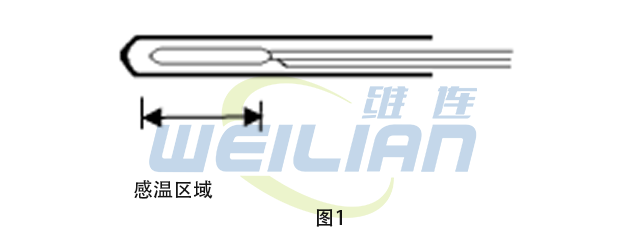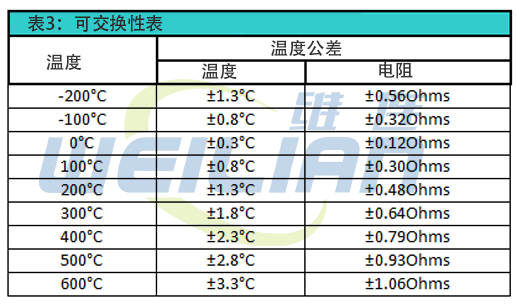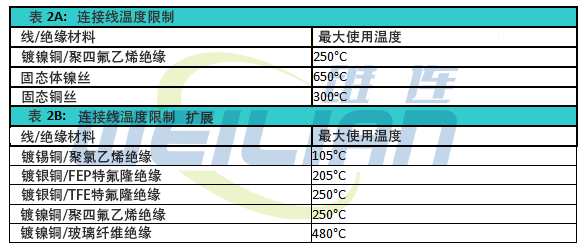 RTD temperature sensor basic principle
RTD temperature sensor basic principleRTD temperature sensor definition: The resistor thermometer, also known as the resistor temperature detector, is a sensor used to measure the temperature.
Resistance thermometer, classification and comparison
Temperature range
The internal assembly structure is divided into two types: low temperature and high temperature:
Low temperature: -200 ° C to + 250 ° C
High temperature: -200 ° C to + 600 ° C
Low temperature: 3 mm, 4.8 mm, 6 mm, 8 mm, 9.5 mm diameter 316 SS tube oxide powder filling.
High temperature: 3 mm, 6 mm diameter 316 stainless steel metal sheets insulation.
DRed configuration and color code

The typical current value recommended for the minimum self -heating sensor is between 1 and 5mA.
RTD temperature sensor basic principle
The thermal release resistance temperature detector (RTDS) is specially designed to ensure accurate and repeated temperature and resistance characteristics. The sensor is built in a unique free strain free way and only uses high -quality RTD elements. According to customer requirements, the use of ceramics, line wound components, flat film technology elements or special military anti -vibration components to ensure the most suitable specifications.
Features and benefits
accuracy. A special process combined with the support of free building and the full entanglement support is reliable. The accurate reading is in the standard RTD component, and the platinum of the plane film component is etched on the substrate.
High -signal noise output, improve data transmission accuracy, and allow a farther distance between sensors and measuring devices.
Interchangeability. No change structure and precision fine -tuning allows different batches to be replaced without re -calibration.
Sensitivity. Self -heating is the smallest and allows accurate measurement. When the insulating resistance value exceeds the IEC-751 standard, the temperature coefficient (alpha) is strictly controlled within the industry standard.
standardization. These elements can meet or exceed the requirements of various standardized agencies. IEC-751 standard tolerance level A and B are very suitable for industrial applications, respectively. As high as 1/10 din, you can also provide higher accuracy requirements
Physics and chemical stability within a wider temperature range. Fireworks sales use a highly controlled manufacturing process. Standard components are to establish resistance and impact resistance, but in the high -exposure of mechanical vibrations and specially manufactured military specifications, thick membrane RTD elements can provide suitable applications.
Even if the temperature is exposed for a long time, the repeatability of all elements exceeds the repetitive value of IEC-751.
Application
• Air adjustment and refrigeration maintenance
• Food treatment
• Stove and grill
• Textile manufacturing
• Plastic processing
• Petrochemical processing
• Microelectronics
• Measure the temperature of air, gas and liquid
• For exhaust gas temperature measurement
When to use the RTD temperature sensor?
• When accuracy and stability are the requirements of customer norms
• When the accuracy must be extended to a very wide temperature range
• Being a area, not a point sensor to improve control
• When a high degree of standardization is required
Advantage:
• Linear in the range of width work
• Wide temperature operation range
• The range of high temperature work
• Broad -range interchangeability
• High temperature stability is good
Shortcoming:
• Low sensitivity
• The cost is higher than the thermal power puppet
• No feeling
• Affected by impact and vibration
• Require three or four -line operations
 Install
InstallWhen installing the RTD temperature sensor element, the main consideration is sufficient soaking to ensure the uneven process and equipment or the temperature outside the Wician RTD temperature sensor. RTD is not as measuring device like armocouple, so there is a need for a active sensing area that is completely immersed to ensure that the RTD temperature sensor is to measure the actual process temperature.
When installing the Welleen thermocouple sleeve, it is essential to pass 40 mm along the heat of the sensor shaft.
Figure 1 shows the activity sensing area of the RTD temperature sensor. This area depends on the length of the RTD temperature sensor used in the construction.
The sensor can be designed to provide average temperature instructions.
Selection of sensors
When choosing the correct RTD temperature sensor for your needs, there are many options to consider:
• Rating temperature
• Tolerance, accuracy and interchangeability
• Time response
• The distance from control or measurement device
Temperature level
The RTD temperature sensor is composed of sensing elements, connecting sensor elements, and the wire of the measuring instrument, as well as a supporting support for positioning sensor elements in this process. Each of these materials has restricted the temperature that the thermal resistance can reach.
The sensitive element is a resistor that changes with temperature. The change of this resistance is understandable and repeated. The sensor element in the resistor temperature sensor usually contains a coil, or a substrate with a platinum etched film. The extension line is connected to the sensor element so that its resistance can measure from a distance. Sensing components insert a protective cover (usually stainless steel). Generally speaking, platinum sensitive elements can be exposed at high temperatures up to 650 degrees Celsius. Other materials, such as nickel or copper, can also be used, but their useful temperature range is lower than platinum. See Table 1 for all these materials.

The use of wire insulation also directly affects the heat resistance of the temperature to be exposed. Table 2A contains commonly used wires and insulation materials and its maximum use temperature. The wires connected to the sensor or the reader or the control instrument are usually made of nickel, nickel alloy, silver -plated copper, or nickel -plated copper and other materials. See Table 2B
The most commonly used structure is to put the Weilian RTD temperature sensor and connecting wires into a closed metal tube, use vibration reduction and/or heat transfer material such as alumina powder to pack the tube, and use epoxy resin, silicon resin or ceramic cement to close the tube The opening end. The most commonly used metal tube in RTD is made of 316 stainless steel (about 480 ° C) or nickel -plated copper (about 650 ° C). Vibration reduction/heat transfer material changes greatly within the temperature. These materials are chosen by the manufacturer to use the highest temperature on the basis of providing the best performance.
Another common structure is to use mineral insulation metal sheath (MIMS) cables, where the RTD temperature sensor is inserted into a drilling hole and connected to the nickel or copper wires that are connected to the magnesium oxide (MGO) insulation. The end of the end is insulated with magnesium oxide, the end is closed, and the other end is connected to the extension line, and then seal as above.
Epoxy resin sealing compounds are usually not used for 200 to 260 ° C. Ceramic cement can be exposed at a temperature of 1200 degrees Celsius or higher, but the sealing agent is required to keep the water from entering the cement, and the vibration suppression/thermal transmission material below.
Materials with the lowest temperature of platinum heat resistance are usually wires and insulating materials used in buildings. There are two structures: low temperature and high temperature. In a low temperature structure, polytetrafluoroethylene insulation nickel -plated copper wire is used to connect the RTD temperature sensor. Stainless steel pipe is a filling alumina powder to provide supportive elements and a sealing of oxygen oxygen. This structure is usually limited to 250 ° C.
High -temperature buildings use nickel lines and ceramic insulators, or MIMS cables contain nickel wires. The nickel lines and ceramic structures are filled with aluminum oxide to support the components. The use of sealing will depend on the transition point of the rated value of the temperature. Both types of structures can be used for about 650 ° C. However, if you carefully select elements and use the Inconel cover MIMS cable, this can be extended to about 850 ° C.
Tolerance, accuracy and interchangeability:
Tolerance and accuracy are the most misunderstood terms in temperature measurement. The word tolerance refers to the uncertainty or possible error on a specific point. Accuracy refers to the infinite number of tolerances within the specified range.
For example, RTDS contains a sensitive element that has a specific resistance at a specific temperature. The most common example of this requirement is the DIN/IEC standard. In order to meet the requirements of the DIN/IEC standard, a RTD must have a resistance of 100 ohm ± 0.12% (or 0.12 ohm) at 0 ° C to be considered a B -class sensor (A -class sensor is 100 ohm ± 0.06%). The tolerance ± 0.12 ohm is only suitable for the resistance of 0 ° C and cannot be applicable to any other temperature. Below is the interchangeable table of Class A RTDS, which provides users with a tolerance table at a specific temperature. See Table 3.
Drotes resistance has a significant impact on the measured resistance. The ability to compensate these additional resistors will affect the selected assembly type and system accuracy. The most common assembly type is the three -line RTD. Here, the lead resistance is compensated in the bridge circuit. In order to achieve the highest accuracy, the only choice is to use a 4 -wire resistor, where the wire resistance error is eliminated.

Time response
When selecting the preparation style that is best for you, the response speed of the sensor to temperature changes must be considered. If the thermocouple sleeve is used, the response time will be greatly increased, and you must pay attention when designing the thermocouple sleeve/sensor system. The inner diameter of the thermocouple case should be closely matched with the diameter of the RTD temperature sensor to achieve good thermal contact and maximize the heat transfer.
If fast response is a standard, the smaller the element and probe, the faster the time response will be. Then weigh between the realized response time and whether the sensor is suitable for the process environment.
The distance from control or measurement device
The location of the RTD temperature sensor will determine the required RTD type. If the control/measurement point is relatively close to the installation sensor, it is feasible to connect the cable directly to the instrument. For a longer distance, check the input specifications of the instrument to determine whether the lead impedance is too large. In these cases, a 4-20mA transmitter is recommended.
(The transmitter of the 4-20mA converts the resistor to current, transmitted through two wires, the minimum loss).
Troubleshooting
Problems related to the RTD program set are often directly solved by it. Because RTD components are susceptible to vibration or mechanical impact, the most likely problem is that the component is open. According to the type of assembly, you can easily determine this with a multimeter.
The drift problem is usually more delicate. Because platinum is easily polluted, the introduction of impurities can change the basic resistance, and the resistance of temperature response is very different from the resistance of pure platinum. In this case, the only way to determine whether there is an error is to calibrate the RTD sensor.
The advantages and disadvantages of RTD temperature sensor
Each type of temperature sensor has its own advantages and disadvantages.
Advantage:
RTD is usually used for repetitiveness and accuracy. It is an important factors for consideration. The correct constructed PT100 RTDS has the temperature characteristics of repeated resistors that changes over time over time. If a process will run at a specific temperature, the resistance of the RTD temperature sensor at this temperature can be measured in the laboratory, and it will not change significantly over time. RTD also allows easier interchangeability because its original change is far lower than the thermocouple. For example, the standard error limit of the K -type thermocouple used in 200 ° C is ± 2.2 ° C. At the same temperature, PT100 DIN, B -class platinum resistor has the interchangeability of ± 1.3 ° C. RTD can also be used with the standard instrument cable to connect to display or control the device. Among them, the thermocouple must have the corresponding thermoelectric puppet line to obtain accurate measurement.
Disadvantages of thermal resistance:
In the same configuration, you can expect more thermal resistance than a basic metal thermocouple. RTDS is more expensive than armocouple, because more structures are needed to make RTDs, including the manufacturing of sensor elements, wiring and sensors. Due to the structure of the sensing element, the performance of RTD in high vibration and mechanical impact environment is not as good as armocouple. The temperature of the industrial RTDS is also limited to 650 degrees Celsius, while the temperature of the thermocouple can be as high as 1700 degrees Celsius.
Thermal resistance or thermal puppet
The thermocouple and RTD temperature sensor are useful sensors to determine the temperature of the process. In its temperature range, the RTD temperature sensor has higher accuracy than the thermocouple, because platinum is a material that is more stable than most thermocouple materials. The RTD temperature sensor also uses a standard instrument line to connect to the measurement or control device, which has the ability to reduce the overall installation cost.
The thermocouple is generally cheaper than the RTD temperature sensor. They are more long -lasting high vibration or mechanical impact applications, which can be used for higher temperatures. The size of the thermocouple can be smaller than most RTD temperature sensors, and they can be formed based on specific applications.

 RTD temperature sensor basic principle
RTD temperature sensor basic principle


 The typical current value recommended for the minimum self -heating sensor is between 1 and 5mA.
The typical current value recommended for the minimum self -heating sensor is between 1 and 5mA.




